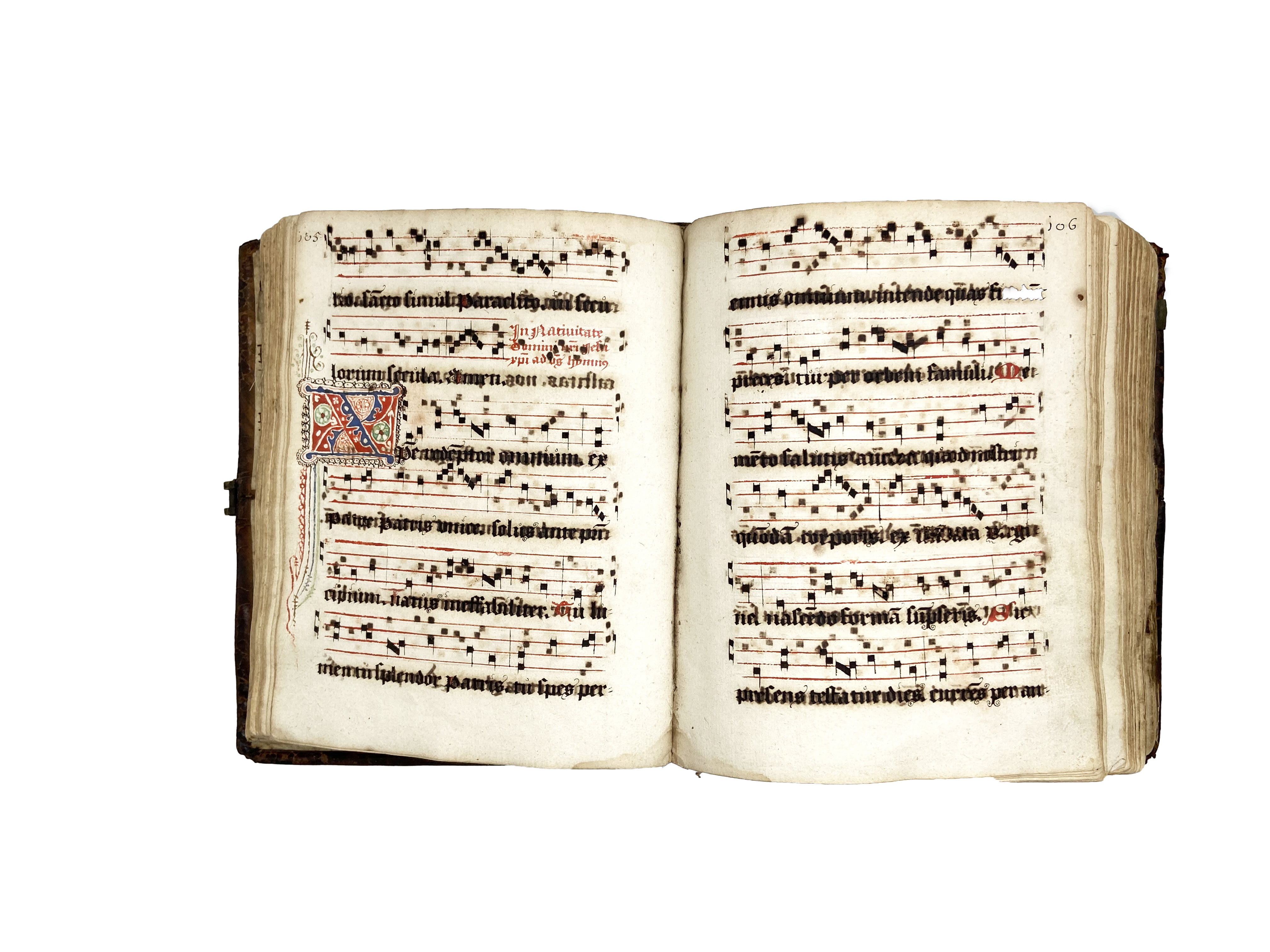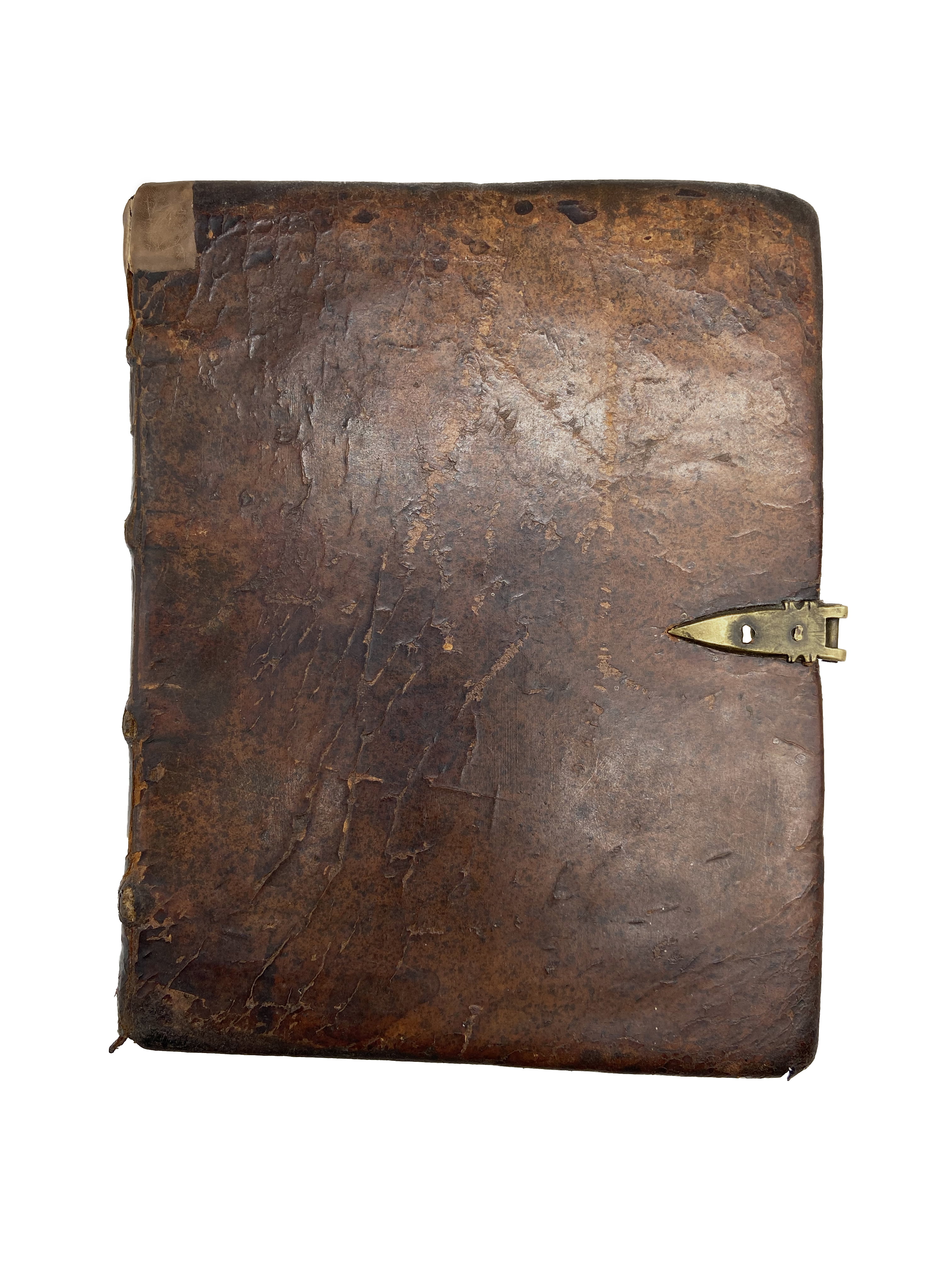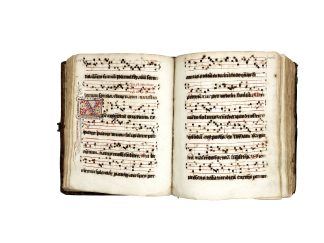HYMNAL AND ANTIPHONAL (Augustinian use)
THE MUSIC OF PLAINCHANT
Illuminated manuscript on paper
[Netherlands], [last quarter of the 16th century, with later additions]£18,500.00
190×150 mm, 299 leaves, including ruled blanks, original text 1-527(2), gap of one or more pages in additions after p. 543, one quire leaves misplaced, a few pages misnumbered. Text in Latin, a few rubrics in Dutch. 6 lines of text per page interspersed with square music notation on a 4-line red stave. Text in dark brown ink in a gothic bookhand, first section (pp. 1-356) with hymns, second section (pp. 357-532) with antiphons and responsories, various additions (including hymns, sequences, versicles, antiphons) at the end in approx. 6 different hands (in humanistic minuscule and less formal gothic bookhand). Red rubrics, page numbers in roman numerals to upper corners. Red initials (some with ornamental voids) in first section, alternating red and black initials to distinguish antiphons and responsories in second. 2 large illuminated initials in red, blue and green with voided ornaments and flowers painted in white, green, brown, yellow, decorated with pen flourishes in red, blue, green and/or dark brown extending to form a partial border. 16 smaller, similarly decorated initials in blue and/or red, some with ornated penwork in red or green. Ink corrosion with minor loss of text or music in some places, tear from foot of one leaf with partial loss of one stave and text on each side, occasional early repairs mostly marginal, some outer edges a bit ink soiled, traces of blue silk bookmarks. In contemporary calf over boards, edges a bit rubbed, spine with surface crackle, gilt ornaments in compartments, cracked at joints but firm (old repair at head), one brass catch plate preserved. Ms. text and music of the introductory prayer “Deus in adiutorum meum intende” to front pastedown, modern bookplate ‘sum Martini heremitae’ to fly.
This charming manuscript, with beautifully decorated initials, comprises the selection of chants for the Divine Office (Liturgy of the Hours), covering the entire duration of the liturgic year. A small and portable volume designed for personal use, it is a very unusual example containing exclusively the music and words of plainchant without any accompanying text.
Divided into two section, marked by large illuminated initials, the first is a repertory of hymns, approximately arranged according to the liturgic year. There are hymns for the major hours (Vespers, Matins and Lauds) of all feast days, and hymns for ‘little hours’ (prime, terce, sext and none) for major occasions. In the typical book of hymns, or ‘hymnal’, music notation was indicated only for the first strophe of each hymn, because the same melody was sung for each strophe of the text. In many cases, notation was completely absent. Exceptionally, this volume has all the strophes of each hymn melody written out in full: this uncommon feature is particularly significant considering its small format. Another interesting characteristic is that the texts of the same four hymns for the ‘little hours’ (‘Iam lucis orto sidere’, ‘Nunc sancta nobis spiritus’, ‘Rector potes veras deus’, ‘Te lucis ante terminum’) are copied identically for several festivities, but each time the melody changes. This allow us to appreciate that not only the text had spiritual value, but also music: certain melodies were considered appropriate for specific feasts or grades of liturgical celebration, and every institution would have its own established customs in this respect. The second section is organised as an antiphoner, containing the texts of introductory antiphons, antiphons, responsories and versicles to be sung in the correct order during the liturgy of the hours. Unusually, it encompasses only a small number of festivities, and it does not rigorously follow the liturgical calendar. Psalms and hymns are not included: this is because the former were known by heart, the latter are already provided in the first section of the book.
The presence of a few hymns written by the cardinals Silvio Antoniano (1540-1603, such as ‘Fortem virili pectore’) and Robert Bellarmine (1542-1561, such as ‘Custodes hominum psallimus’), allow us to date this manuscript approximately to the last quarter of the 16th century, possibly to the 1570s. A ‘terminus ante quem’ for the main text is provided by ‘Iam Christe, sol iustitiae’, which does not include the alterations introduced by Pope Urban VIII in 1632. The evidence of the script of the final additions indicate that the manuscript was expanded and used probably till the end of the 17th century. Liturgical music manuscripts continued to be produced and used long after the invention of printing in 1455. This is because in most cases, they were meant to be unique objects – such as this one: every monastic or urban foundation required different music suited to the local, and even individual, requirements of place and patron. In these circumstances, an imprint would have been uneconomical.
The book was clearly made for Augustinian use; note the hymn and the office for “St. patri nostri Augustini” (‘our holy father St. Augustine’, ll. 86 and 398) and the hymn for St. Monica, Augustine’s mother (fol. 253). The initials of these chants are also richly decorated. The final additions include more prayers and chants written or dedicated to St. Augustine. Remarkably, ff. 551-52 contain citations from Agustine’s ‘Confessiones’ with music. The particular arrangement and number of chants and psalms in the antiphonal section reflects the so called ‘secular cursus’ (as opposed to the ‘monastic cursus’), which was practiced in churches, cathedrals and some religious orders, including the Augustinian Hermits.
The pen decoration and style of the illuminated initials, as well as the rubrics in Dutch, suggest that the volume was produced in the Netherlands, possibly in the south (see Andriolo and Reynolds no. 131 and 136 for similar examples). Following the success of the Dutch revolt, the Calvinist Church became the sole officially recognized Church in the territory of the new Dutch Republic. As a consequence, in 1572, Augustinian friars were expelled from the monasteries in the north (Dordrecht, Middleburg, Enkhuizen, Haarlem) and forced to flee to their confreres in the south. The only Augustinian friary which survived was Maastricht (southern Netherlands), and it is therefore probable that this volume was produced there. It should be noticed, however, that the monastery of Haarlem remained active until 1578. The modern bookplate reads ‘[I belong to] Martinus the hermit’. A certain Brother Martin of Padua, hermit of the order of St. Augustine, is known from a manuscript ex-libris (late 15th century hand) on a volume printed in Italy and illuminated in the Netherlands, in a style that can be attributed to artists active Haarlem (see Andriolo and Reynolds no. 132).
A.E. Andriolo and S. Reynolds, Illuminated Manuscripts and Incunabula in Cambridge, Books Printed in Italy before 1501 (2017)In stock







